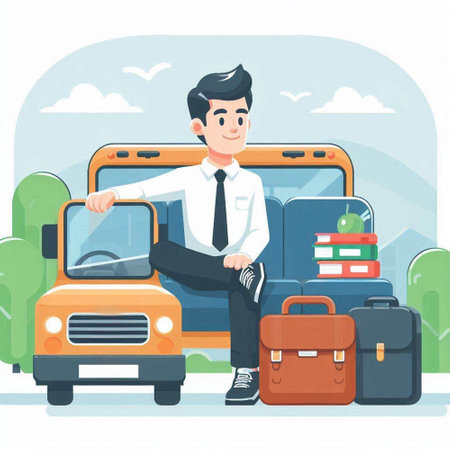The Heart of the Indian Commute: Family First
In India, every journey is more than just a point A to point B affair – it’s a family experience. Whether weaving through the hustle of Mumbai’s traffic or navigating the peaceful bylanes of a small town in Kerala, Indian families have always placed their loved ones at the centre of all commuting decisions. For parents and grandparents, the question is never simply about reaching a destination; it’s about ensuring that children and elders travel with utmost safety and comfort. The Indian approach to daily travel is deeply influenced by strong family bonds, cultural values, and a collective mindset that prioritises care over convenience. It’s not uncommon to see a parent holding their child close on a crowded bus, or an elder being assisted gently into an autorickshaw by a concerned grandchild. This family-centric perspective shapes how Indians view public transport versus private cars, often leading to heartfelt debates at home about what truly matters: affordability, accessibility, or the peace of mind that comes with knowing your loved ones are safe and comfortable throughout their journey.
Challenges of Public Transport for Kids & Elders
For many Indian families, deciding between public transport and a private car is not just about costs but also about safety, comfort, and practicality—especially when it comes to children and elders. The reality of daily commuting in our cities brings forward several concerns that can make public transport a tough choice for these vulnerable groups.
Crowded Buses and Trains
The first challenge everyone talks about is the crowd. During peak hours, buses and local trains in cities like Mumbai, Delhi, or Bengaluru are packed beyond capacity. For elders who may have mobility issues or require seating, standing in a jam-packed compartment can be daunting. Similarly, young children are at risk of getting pushed or separated from their guardians. The lack of personal space often leads to discomfort and anxiety, especially when traveling long distances.
Inconsistent Schedules
Unlike the predictability that comes with owning a private car, public transport timetables in India can be unreliable. Delays due to traffic jams, breakdowns, or sudden strikes (bandhs) are common. This inconsistency makes it difficult for parents to plan school drop-offs or hospital visits for elders. Missing a bus or train could mean waiting an extra 30 minutes or more—something neither children nor elderly people handle well.
Accessibility Issues
Physical accessibility remains a major problem. Many bus stops and train stations lack ramps, lifts, or escalators. Boarding a high-step bus or crossing railway footbridges can be risky for seniors with joint pain or limited mobility and challenging for parents carrying toddlers or strollers. The absence of proper signage and audio announcements further complicates matters for those with visual or hearing impairments.
Key Physical Challenges Faced
| Challenge | Kids | Elders |
|---|---|---|
| Standing for long durations | Fatigue, crankiness | Knee/hip pain, risk of falls |
| Poor ventilation & hygiene | Susceptible to infections | Respiratory issues |
| Lack of seating priority | No guarantee of seats even in “ladies” compartments | Insufficient “senior citizen” reserved seats |
A Family’s Dilemma on Indian Roads
The cumulative effect of these challenges means that public transport often feels like an endurance test rather than a convenient travel option. This is why so many Indian families—especially those with young kids and elderly members—are forced to weigh the convenience and comfort of private cars against the cost savings and eco-friendliness of public transit.

3. Private Car: Flexibility, Comfort, and Mahol in India
For Indian families, especially those with kids and elders, owning a private car is not just about convenience—it’s about lifestyle and dignity. The flexibility of having your own vehicle means you can travel according to your own schedule, take unplanned halts for chai breaks, and enjoy the comfort of air conditioning while escaping the unforgiving heat and dust on Indian roads. Unlike public transport, where personal space is a luxury, a private car offers privacy for family conversations, napping children, or even singing along to Bollywood hits without hesitation.
There’s also the aspect of ‘mahol’—the unique atmosphere inside a family car that brings everyone together. Whether it’s sharing tiffin snacks or listening to dadi’s stories during long drives, these moments are priceless for bonding. For elders, the ability to adjust seats and control the environment adds to their comfort and safety, especially when compared to crowded buses or auto-rickshaws.
However, this comfort comes with its own set of challenges. The rising cost of petrol and diesel in India has made every outing an exercise in budgeting. Maintenance costs—from periodic servicing to surprise punctures—can weigh heavily on middle-class families. And no one can ignore the infamous traffic jams in cities like Bengaluru, Mumbai, or Delhi; what should be a 20-minute drive often turns into a test of patience. These daily snarls not only waste time but also add stress for both drivers and passengers.
Despite these hurdles, for many Indian parents and grandparents, the peace of mind knowing their loved ones are safe from unpredictable public transport situations makes investing in a private car worth it. In short, while private cars offer unmatched comfort and flexibility in Indian conditions, they are accompanied by significant costs and urban headaches that every family must weigh carefully.
4. Safety and Security – The Deciding Factors
For Indian families, especially those with kids and elders, safety and security play a pivotal role in transportation decisions. Whether living in bustling metros like Mumbai or quieter small towns, parents and caregivers are constantly weighing the pros and cons of public transport versus private cars when it comes to keeping loved ones safe.
Road Manners and Traffic Discipline
The unpredictability of Indian roads is notorious. Lane discipline is often ignored, overtaking from the wrong side is common, and honking is relentless. For children and elderly passengers, these chaotic conditions can be stressful and even dangerous. In a private car, families feel more in control—drivers can adjust speed, avoid risky shortcuts, and ensure seatbelts or child seats are used. In contrast, buses and autos may pack passengers beyond capacity, leaving little room for comfort or safety.
Personal Security Concerns
Security is another pressing issue, especially in big cities after dark. Reports of petty thefts, harassment, or even assaults on public transport make parents anxious about sending kids alone or travelling with elderly family members. Private cars offer the comfort of familiarity and privacy, while in public buses or shared autos, strangers are part of the journey—sometimes leading to unpleasant experiences.
Real Stories from Indian Cities & Towns
Take the example of Mrs. Shalini Sharma from Delhi: “I tried sending my son by school bus, but after hearing about pickpocketing incidents near the bus stop, I decided to drop him myself.” In smaller towns like Kota or Salem, families might feel safer as everyone knows each other, but overcrowding in local rickshaws still raises concerns about physical safety during bumpy rides.
Comparing Safety Aspects: Public Transport vs Private Car
| Aspect | Public Transport | Private Car |
|---|---|---|
| Road Safety | Driver behavior unpredictable; Overcrowded vehicles; Limited control over speed/routes | Full control over driving style; Can use seatbelts/child seats; Safer for vulnerable passengers |
| Personal Security | Exposure to unknown co-passengers; Risk of theft/harassment; Less secure at night | Private environment; Trusted company; Safer during late hours |
| Emergency Response | May take time to get help in crowded areas; Difficult to exit quickly in emergency | Easier access to first aid kit and essentials; Immediate action possible if needed |
Ultimately, while cost and convenience matter, it’s the daily stories—of close calls on busy roads or reassuring drives home—that tip the scales for most Indian families. The desire for a safe and secure journey often makes private cars the preferred choice when kids and elders are involved.
5. Long Journeys: ‘Desi Road Trips’ and Their Memories
When Indian families plan long journeys, the great ‘desi road trip’ holds a special place in our collective memory. For kids and elders alike, piling into the family car for a cross-state adventure is more than just travel—it’s an experience layered with nostalgia and unique Indian flavours. Picture this: as you drive along the highway, the car is filled with laughter, Antakshari games echoing from the back seat, and an ever-present box of homemade aloo parathas passed around. Every so often, someone shouts, “Chai break!” and the car pulls up at a roadside dhaba. The joy of sipping hot chai in kullads while munching on crispy pakoras, with trucks rumbling by and the smell of tandoori wafting in the air—this is what makes Indian road trips unforgettable.
For elders, these breaks are not just about food but about stretching their legs and sharing stories of their own youthful journeys. Children get to run around safely, away from stuffy bus aisles or crowded train compartments. The family bonds grow stronger as everyone shares jokes or marvels at changing landscapes—from mustard fields in Punjab to coconut groves down South.
Contrast this with public transport: while trains like Rajdhani or Shatabdi offer comfort and even some glamour, long spells can be tiring for seniors who find it hard to climb upper berths or use cramped washrooms. Bus journeys, especially in rural areas, often involve bumpy roads and unpredictable stops. There’s little room for spontaneous detours—no stopping for that irresistible jalebi stall or scenic photo-op. For kids, boredom sets in quickly without the freedom to sprawl out or play games together.
Ultimately, while public transport has its perks—cost savings, environmental friendliness, and no driving fatigue—it rarely matches the intimate joys of a private car journey. The flexibility to travel at your own pace, indulge in local delicacies along the way, and create lasting memories makes all the difference for Indian families travelling with kids and elders.
6. Aspirations, Status, and Social Perception
In India, the decision between using public transport and owning a private car is deeply influenced by more than just convenience or affordability—it’s also about aspirations, social status, and cultural values. For many Indian families, especially those with children and elders, having a personal car is not merely a means of transportation. It is a symbol of progress, pride, and an improved standard of living. When elders are present in the household, the desire to provide them with comfort and dignity amplifies the urge to own a vehicle. Taking your parents or grandparents out for a drive in your own car, rather than navigating crowded buses or autos, brings immense satisfaction—both for their comfort and for the family’s reputation in society. In urban India, neighbours and relatives often perceive car ownership as an indicator of success and prosperity. Children too, feel a sense of pride when they are dropped off at school in a family car. Elders take pleasure in sharing stories about their son or daughter buying their “first car”—a significant milestone in any Indian household. While public transport is practical and economical, it rarely offers the same sense of personal achievement or societal recognition. Thus, for many Indian families facing the dilemma between public transport and private cars, it’s not just about mobility—it’s about fulfilling aspirations, gaining respect in the community, and creating cherished memories for both kids and elders.
7. The Road Ahead: Eco-Friendly Choices and Urban Planning
As Indian cities grow and the challenges of commuting with children and elders persist, the conversation is shifting towards greener mobility options. With rising concerns over air pollution and urban congestion, both families and policymakers are re-evaluating the balance between private cars and public transport for daily travel needs.
One major shift is the increasing popularity of metro systems in metros like Delhi, Bengaluru, and Hyderabad. For families, the metro offers a punctual, reliable, and air-conditioned alternative to navigating traffic jams in personal vehicles. Especially for school-going kids and retired elders, metros reduce travel fatigue and offer a sense of safety due to their security protocols. Parents also appreciate that children can commute independently as they grow older, thanks to smart cards and surveillance on platforms.
On the other hand, electric vehicles (EVs) are gaining traction among urban middle-class families who wish to maintain the comfort of a private car while minimizing their carbon footprint. The government’s push for EV adoption through subsidies, charging infrastructure, and awareness campaigns has made it easier for families to consider this eco-friendly upgrade. For those who still prefer door-to-door convenience—especially when traveling with elderly parents or toddlers—EVs strike a balance between sustainability and comfort.
The future of family mobility in India may well be a hybrid approach: using metro or buses for routine commutes like school and office runs, while relying on private EVs for medical emergencies or family outings where flexibility is key. Urban planning will play a crucial role here—city authorities need to ensure last-mile connectivity through feeder buses, e-rickshaws, and safe pedestrian zones so that both kids and elders can comfortably access public transport nodes without hassle.
Ultimately, as Indian society grows more environmentally conscious and cities invest in smarter transport solutions, it’s likely that future generations will prefer eco-friendly travel modes. Children growing up today may see owning a car less as a status symbol and more as a thoughtful choice based on actual needs. Elders too might find themselves adapting to new-age mobility apps, booking electric taxis or using accessible metro stations to stay connected with their loved ones across town.
The dilemma between public transport and private cars will continue to evolve—but with sustainable policies, improved infrastructure, and collective awareness, Indian families can look forward to safer, greener journeys for both young minds and wise elders.


